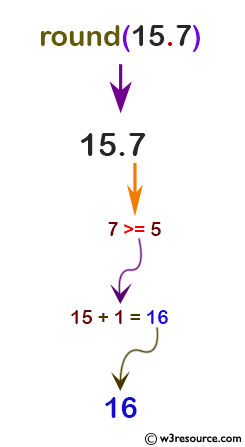Python: round() function
round() function
The round() function returns the rounded floating point value number, rounded to ndigits digits after the decimal point. If ndigits is omitted, it defaults to zero.
Note: For the built-in types supporting round(), values are rounded to the closest multiple of 10 to the power minus ndigits; if two multiples are equally close, rounding is done toward the even choice (so, for example, both round(0.5) and round(-0.5) are 0, and round(1.5) is 2). The return value is an integer if called with one argument, otherwise of the same type as number.
Version:
(Python 3.2.5)
Syntax:
round(number[, ndigits])
Parameter:
| Name | Description | Required / Optional |
|---|---|---|
| number | Number to be rounded. | Required |
| ndigits | The number of decimals to use. Default is 0 | Optional |
Return value:
Floating point value number.
Example-1: Python round() function
# for integers
print(round(5))
# for floating point
print(round(15.7))
# even choice
print(round(7.3))
Output:
5 16 7
Pictorial Presentation:

Pictorial Presentation:

Example-2: Python round() function
print(round(5.7754, 2))
# cannot be represented exactly as float
print(round(5.6758, 3))
Output:
5.78 5.676
Python Code Editor:
Previous: reversed()
Next: set()
Test your Python skills with w3resource's quiz
Python: Tips of the Day
Find current directory and file's directory:
To get the full path to the directory a Python file is contained in, write this in that file:
import os dir_path = os.path.dirname(os.path.realpath(__file__))
(Note that the incantation above won't work if you've already used os.chdir() to change your current working directory, since the value of the __file__ constant is relative to the current working directory and is not changed by an os.chdir() call.)
To get the current working directory use
import os cwd = os.getcwd()
Documentation references for the modules, constants and functions used above:
- The os and os.path modules.
- The __file__ constant
- os.path.realpath(path) (returns "the canonical path of the specified filename, eliminating any symbolic links encountered in the path")
- os.path.dirname(path) (returns "the directory name of pathname path")
- os.getcwd() (returns "a string representing the current working directory")
- os.chdir(path) ("change the current working directory to path")
Ref: https://bit.ly/3fy0R6m
- New Content published on w3resource:
- HTML-CSS Practical: Exercises, Practice, Solution
- Java Regular Expression: Exercises, Practice, Solution
- Scala Programming Exercises, Practice, Solution
- Python Itertools exercises
- Python Numpy exercises
- Python GeoPy Package exercises
- Python Pandas exercises
- Python nltk exercises
- Python BeautifulSoup exercises
- Form Template
- Composer - PHP Package Manager
- PHPUnit - PHP Testing
- Laravel - PHP Framework
- Angular - JavaScript Framework
- Vue - JavaScript Framework
- Jest - JavaScript Testing Framework
